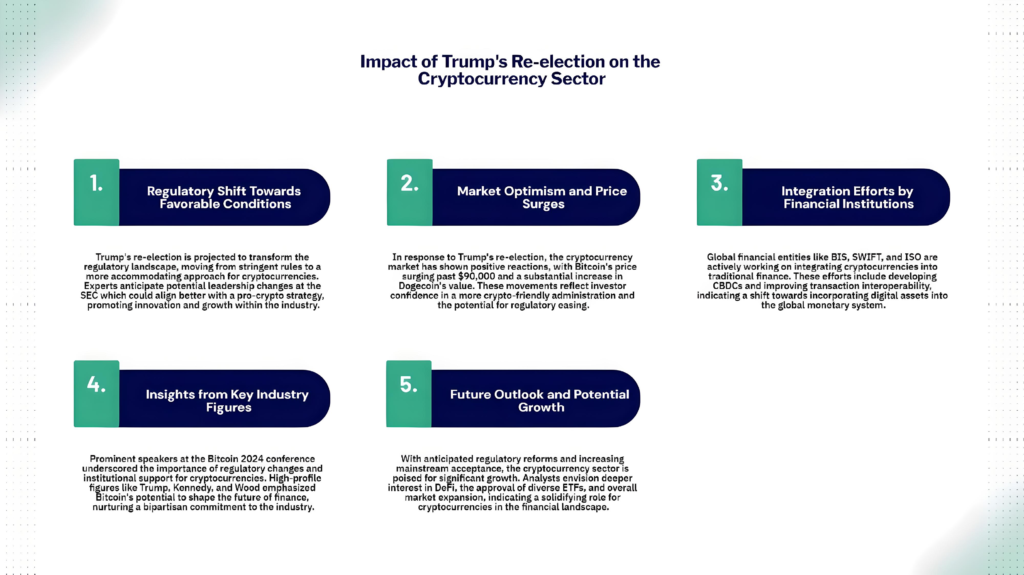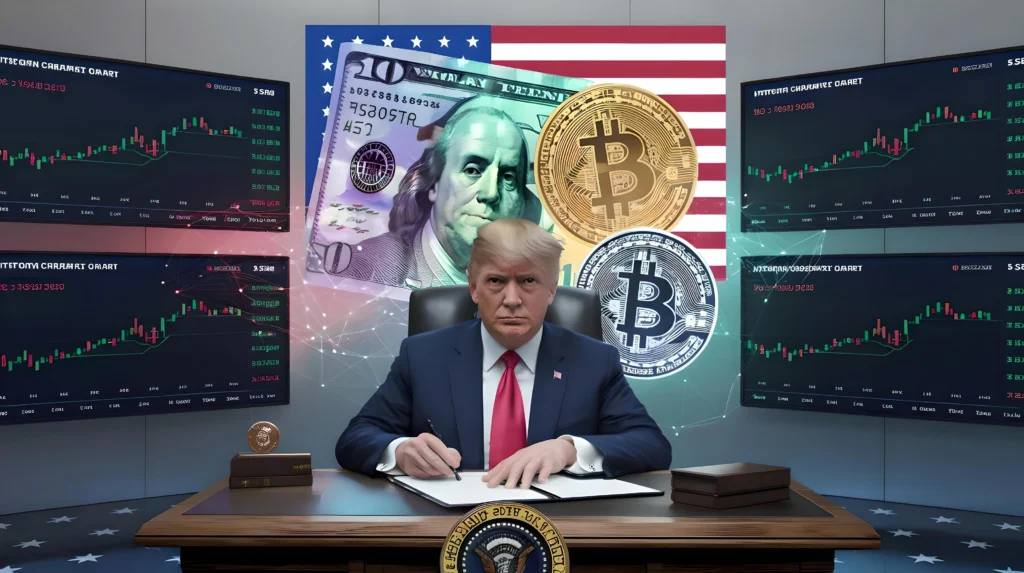
- November 14, 2024
- Dennis Frank
- 0
Table of Contents
Trump’s Re-election: A New Era for the Cryptocurrency Sector
Article By Dennis Frank
November 14, 2024
The re-election of Donald Trump on November 5, 2024, is already reshaping the cryptocurrency sector, influencing regulatory frameworks, market dynamics, and industry expectations. In this assessment, we’ll explore how the return of Trump to office is expected to impact crypto policies, key industry figures, and market reactions.
Regulatory Landscape and Key Figures
Under Trump’s previous administration, the cryptocurrency industry faced stringent regulations, with numerous enforcement actions taken against various projects. These stringent regulations were largely driven by concerns around financial stability, fraud, consumer protection, and national security.
The SEC, under the leadership of Jay Clayton, took a particularly aggressive stance, cracking down on projects that did not comply with securities laws, which created an environment of uncertainty. Additionally, Gary Gensler, who succeeded Clayton as SEC Chair, continued the stringent regulatory approach and has been a prominent figure in suppressing crypto growth. Gensler emphasized that most cryptocurrencies fall under existing securities laws, resulting in multiple enforcement actions and ongoing tension between the industry and regulators.
However, the re-election of President Trump is anticipated to bring a shift towards a more favorable regulatory environment for digital assets. Many experts believe that this change could fuel growth and innovation across the crypto landscape. It remains uncertain if Gensler will keep his position as SEC Chair, given Trump’s preference for a more crypto-friendly regulatory approach.
There is speculation that Trump may replace Gensler with someone more aligned with a pro-crypto stance. Potential successors include Dan Gallagher, Chief Legal Officer at Robinhood and former SEC Commissioner known for his supportive views on crypto, Richard Farley, a well-regarded financial lawyer, or Hester Peirce, the current SEC Commissioner often called “Crypto Mom” for her advocacy of digital assets.
One of the key voices in shaping the regulatory conversation is Jay Clayton, the former Chairman of the U.S. Securities and Exchange Commission (SEC). Clayton has indicated that Congress is likely to adopt comprehensive cryptocurrency legislation under the Trump administration. He emphasized that resolving certain issues at the executive and administrative levels could greatly facilitate the adoption of such legislation. This potential for a more coherent and supportive framework has raised hopes across the industry.
Further boosting optimism, President Trump has announced the creation of a new government body—the “Department of Government Efficiency” (DOGE)—which will be spearheaded by Elon Musk and Vivek Ramaswamy. The department’s mission is to improve government functionality, curb excessive regulation, and reduce wasteful spending. Such initiatives could benefit the crypto sector by streamlining government processes and allowing room for technological innovation, especially given the focus on cutting through bureaucratic red tape.

Market Reactions and Predictions
The cryptocurrency market has responded positively to Trump’s re-election, as evidenced by Bitcoin’s significant price surge. Bitcoin surpassed $90,000 in the days following the election, driven largely by investor expectations of a crypto-friendly administration. The market’s upward trend reflects renewed optimism about potential regulatory easing and greater adoption of digital assets in the near future.
Additionally, Dogecoin’s value experienced a substantial increase, jumping nearly 20% after the announcement of the DOGE department. The creation of this department, with its playful name that alludes to Dogecoin, has been interpreted by many as a positive nod toward the meme-inspired cryptocurrency. The surge has fueled enthusiasm among Dogecoin investors and highlighted the symbolic importance of government action for market sentiments.
The global cryptocurrency market capitalization has also reached new heights, soaring to a record $3.2 trillion. This milestone surpasses previous highs from 2021, underscoring the renewed enthusiasm and investment pouring into the crypto sector after the election. Analysts believe this surge is driven not just by market speculation, but by a realignment of policies and public perception around digital currencies.
JPMorgan Chase has also made projections regarding the future size of the cryptocurrency market. In a 2021 report, JPMorgan analysts suggested that if Bitcoin were to achieve parity with gold as an alternative asset, the overall cryptocurrency market capitalization could potentially reach $11 trillion. This projection aligns with the idea that cryptocurrencies could see substantial growth over the next decade, driven by increased institutional investment and mainstream acceptance.
However, it’s important to recognize that such projections are speculative and depend heavily on various factors, including regulatory developments, technological advancements, and market adoption rates.
Integration Efforts by BIS, SWIFT, and ISO Messaging Systems
In parallel with political and market shifts, several major international financial bodies have been working to integrate digital assets into the global financial landscape. The Bank for International Settlements (BIS), SWIFT, and the ISO messaging systems are all actively exploring how cryptocurrencies can be part of the future of finance.
The BIS has been exploring the potential of tokenization and central bank digital currencies (CBDCs) to enhance the global monetary system. In its 2023 Annual Economic Report, the BIS laid out a blueprint for a future monetary system leveraging tokenization to improve efficiency and introduce new functionalities. This includes CBDCs, tokenized deposits, and other forms of tokenized claims, integrated within a unified ledger to facilitate seamless transactions.
SWIFT, on the other hand, has been actively working on integrating digital currencies and tokenized assets into its infrastructure. In October 2024, SWIFT announced plans to trial live transactions involving tokenized assets and digital currencies, aiming for full-scale integration in 2025.
This initiative aims to enable the seamless movement of tokenized assets across different platforms, supporting greater interoperability in the financial ecosystem. Additionally, SWIFT has conducted industry-wide testing to link CBDCs with existing financial infrastructure, further supporting the inclusion of digital currencies in cross-border transactions.
The ISO 20022 messaging standard is also being adopted globally to enhance the efficiency and interoperability of financial transactions. Cryptocurrencies that comply with ISO 20022, such as Ripple’s XRP and Stellar Lumens (XLM), are well-positioned for integration into traditional financial systems.
The adoption of ISO 20022 standards is a significant step towards ensuring that cryptocurrencies can seamlessly communicate with conventional financial institutions, further legitimizing their role in global finance.

Insights from Keynote Speakers at the Recent Bitcoin Summit
The recent Bitcoin 2024 conference in Nashville featured several prominent keynote speakers whose insights are highly relevant to the evolving cryptocurrency landscape. President Donald Trump himself was a keynote speaker, where he reiterated his support for the American Bitcoin industry, emphasizing the need for financial freedom and positioning the U.S. as a leader in the global Bitcoin market. This aligns directly with the anticipated regulatory easing under his administration, which many believe will stimulate industry growth.
Robert F. Kennedy Jr., an independent presidential candidate, also expressed his support for Bitcoin, highlighting its role in promoting financial freedom and innovation. This bipartisan interest in fostering cryptocurrency and blockchain technology is a positive indicator for future regulatory harmony and broad-based support across political lines.
Cathie Wood, Founder and CEO of ARK Invest, underscored Bitcoin’s potential as a transformative asset class. Her projection that Bitcoin could reach $1 million by 2030 highlights the increasing confidence among institutional investors and reinforces the idea of substantial future market growth, potentially driving the market cap well into multi-trillion dollar territory.
Michael Saylor, Executive Chairman of MicroStrategy, shared his continued enthusiasm for Bitcoin as a strategic reserve asset. Saylor’s advocacy for institutional adoption aligns with recent market trends, and his comments further bolster the narrative that corporations will increasingly look to Bitcoin as a store of value, adding to the sector’s credibility.
Edward Snowden, whistleblower and cybersecurity expert, provided important commentary on privacy and security in the digital age. He stressed the importance of regulatory frameworks that protect users’ privacy without stifling innovation. His perspective is crucial as regulators and industry leaders attempt to strike a balance between oversight and the inherent decentralized nature of cryptocurrencies.
Industry Outlook
Leaders in the crypto space are expressing optimism about the future under the Trump administration. Coinbase CEO Brian Armstrong has gone as far as labeling this period the “dawn of a new crypto era,” stating that he hopes to see a shakeup at the SEC and the introduction of clear, favorable digital asset regulations. A shift towards a more supportive regulatory framework could help companies innovate freely, without the constant threat of enforcement actions or changing compliance requirements.
Moreover, analysts are predicting that sustained market growth could lead to deeper interest in decentralized finance (DeFi) and other blockchain-related services. The prospect of more diverse cryptocurrency exchange-traded funds (ETFs) being approved is also anticipated, potentially driving even more mainstream adoption. This development could allow a broader segment of traditional investors to access cryptocurrencies with fewer barriers.
Conclusion
The re-election of President Donald Trump has set the stage for significant transformations in the cryptocurrency industry. With anticipated regulatory reforms, a favorable market environment, and active engageme
nt from industry leaders, the sector appears poised for a new era of growth and innovation. The commentary from recent keynote speakers at the Bitcoin 2024 conference—highlighting themes of regulatory change, institutional adoption, and privacy—further reinforces the optimistic outlook for the industry.
Additionally, the ongoing efforts by major international financial entities such as BIS, SWIFT, and ISO standards bodies to integrate digital assets indicate a strong foundation for the future of cryptocurrencies within the global financial system. If these changes come to fruition, the next few years could see cryptocurrencies solidifying their place as a major component of the global financial system.
The road ahead, however, will depend on the actual policies implemented and how effectively government entities can collaborate with the private sector. It is an exciting time, full of possibilities, and those invested in the space will be watching closely as this new chapter unfolds.
See articles, Videos, and more at KryptoKraken.com
Youtube Channel https://www.youtube.com/@mykryptokraken
















































































